1977 Spanish Grand Prix race report
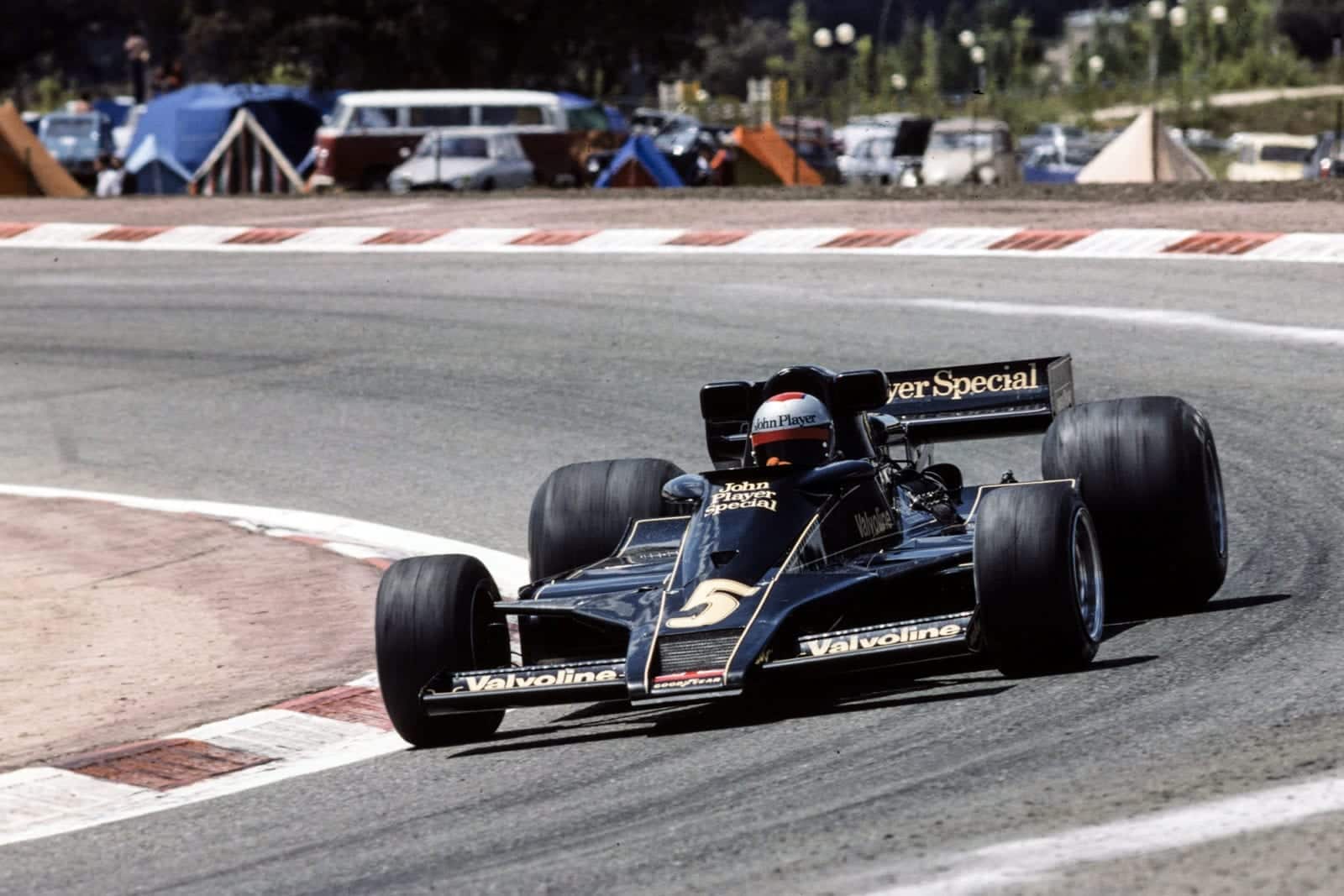
Mario Andretti claimed win No 2 of the season for Lotus
Motorsport Images
Andretti and Lotus in form again
Jarama, Madrid, May 8th
After racing in South America, South Africa and on the West Coast of the United States of America the Grand Prix scene returned to Europe with the Spanish Grand Prix run over 75 laps of the “mickey-mouse” Jarama circuit. By rotation it should have been held at Barcelona in the Montjuich Park, but after the accident caused by a design failure on the Hill car, Formula One in the park was finished. The artificial Jarama circuit does have the distinction of a good fast uphill left-hand bend, and a very fast downhill right-hander leading into a long (by today’s standards) straight, with a hairpin at the end of it. The rest of it is more suited to Kart racing, the Formula One cars having to go through a series of “point-squirt-brake” motions. The average speed is around 95 m.p.h. and the average corner speed is a mere 65 m.p.h.; as a young colleague remarked, “Hardly the stuff from which motor racing legends are made”. However, the Real Automovil Club de España came up with the necessary money so Ecclestone and Mosley allowed their Association members to take part. Fortunately the weather stayed warm and dry and an enormous crowd turned up to pay for it all.
Practice was noticeable for the crowded conditions on the track with far too many cars trying to get into the fastest 24 that were to be allowed to start the race. There were lots of new faces in new places as well as some old ones, and some complete newcomers to the world of Grand Prix. Ian Scheckter was back with the works March team after his lay-off following an accident in South African racing, and he was 100% fit again. In contrast, Niki Lauda was looking anything but fit, seemingly having made little physical progress since last year, and being carried along by sheer will-power and determination. Rupert Keegan was making his Grand Prix debut with the new Hesketh, following his good showing at the Race of Champions, and Harald Ertl, the bearded Austrian, was in the second new Hesketh. Frank Williams had started up a new team with a March 761 and the young Belgian Patrick Neve as driver, while David Purley was entering the fold with his LEC (CRP/1) designed by Mike Pilbeam. The Spaniard Villota had acquired an ex-works McLaren M23, Connie Anderson had replaced Larry Perkins in the blue and white BRM (P207/01) and Brian Henton was running his own March 761, having had a brief moment of glory in the works March while Ian Scheckter was convalescing. Arturo Merzario returned to the fray as a private entrant of an ex-works March 761B.
Qualifying
On Friday morning there was the usual 1 1/2 hours of practice free-for-all in which cars spun, went over kerbs, broke engines, gearboxes, minor parts and major parts and through it all rang loud and clear that Colin Chapman and Mario Andretti had arrived at that desirable point where they not only thought on the same wave-length but were ahead of each other by equal amounts and every answer they came up with was the right one. Everything was clicking into place to perfection, whereas other teams seemed to be in a shambles. If BRM had not won the Shambles Trophy outright many years ago, it would have been a close contest between Tyrrell and McLaren for honours, Tyrrell with a new car to old thinking and McLaren with old thinking and a new car. Meanwhile Andretti and the Lotus 78 were disappearing into the distance. Whether it was due to the Italian’s (naturalised American) driving, the clever aerodynamics of the 78, the John Nicholson Cosworth DFV engine, the differential-less rear axle, the water poured over the tyres before each fast lap, or a combination of all these and Chapman’s control of things we’ll never know, but a lap in 1 min. 18.70 sec. left everyone else breathless, and caused McLaren and March personnel to appear at the Lotus pit to see if Chapman was cheating in some way. Just as contented cows give good milk, contented drivers go very fast, and Mario Andretti was really looking contented. His nearest rival was Jacques Laffite with the Ligier-Matra V12, with a time of 1 min. 19.42 sec. and Watson and Reutemann were the only others to break the 1 min. 20 sec. barrier. Normally one would say that anyone with a lap in the 1 min. 19 sec. bracket would be an “ace”, but now we had to put Andretti in the “super ace” category and throughout practice nobody looked like joining him. The Ferrari team seemed to be suffering from a lack of anyone being in full control, the brilliant Mauro Forghieri not being present, while the Tyrrell team seemed to be lacking a sense of direction. McLaren’s were struggling to come to grips with the new M26, James Hunt trying all he knew, and some that he didn’t know, in his efforts to get to the front of the grid. At one point he ran over the back of Hans Stuck’s Brabham-Alfa Romeo and did his popular “flying act” fortunately without damage.
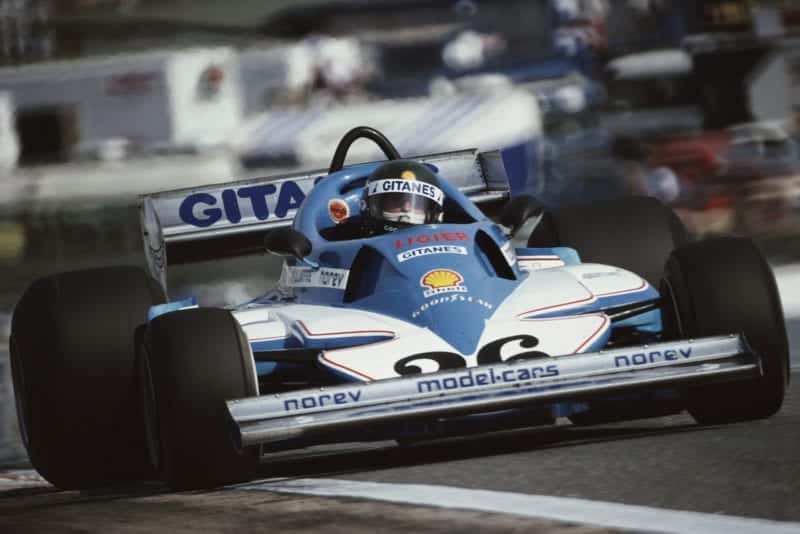
Jacques Laffite qualified 2nd in his Ligier
Motorsport Images
That Andretti’s fast lap was not a lucky fluke could be seen by the way he could do 1 min. 19.1 sec. on laps on which he was baulked or held up by slower cars, lap times that still kept him ahead of everyone else. This time last year I had despaired of Andretti ever “coming good” but now I was happily eating my words, though at times I did wonder if he was the same as he’s always been and that the opposition have deteriorated! In the afternoon the conditions were a lot warmer and slower overall, but still the combination of Andretti and Lotus were uncatchable, though Scheckter joined the elite, but not close enough to worry the Lotus team. It was still FTD to Andretti and some teams began to progress backwards in their efforts to juggle the variables. With everything about a Formula One car being adjustable each side of a mean setting, even the driver in some cases, it is not surprising that few teams can get 8 out of 10 right, or 8 plusses. Some, like the Fittipaldi team, seem to keep coming up with 8 minuses, while others like BRM don’t seem to be able to tell a plus from a minus. At the end of the first practice the Bourne world-beater was seen being towed in behind a breakdown lorry. I just could not bring myself to ask what awful thing had befallen the car, not after the “trumpet voluntary and pomp and circumstance” of the car’s introduction at the London Dorchester Hotel last winter.
The majority of the usually fast runners were so appalled at how far behind the Lotus-Cosworth V8 they were, that they seemed to overlook the fact that they hadn’t even caught the Ligier-Matra V12!
In spite of stories to the contrary in South Africa, the Saturday morning practice session was untimed, in accordance with the dictates of Goodyear, but you would not have known it. No-one was doing full-tank testing or tyre-scrubbing, they were all going like hell to try and break into the “super ace” class. Some of the tail-enders were still trying to get going properly, like Jarier with the yellow Penske, for the gearbox had broken in both sessions the day before, and now he was feeling sick. David Purley was going to feel sick, as the previous day he had been delayed by differential trouble and now that he’d got everything going properly the times did not count for the starting grid. In the final hour he was unable to repeat the times and failed to qualify. As this “tyre-scrubbing and full-tank testing session” ended Hunt lost the McLaren M26 in a big way on the fast right-hander before the pit-straight and crumpled the nose in the barriers, but damage was light. He was certainly trying hard.
The final hour of practice saw a mad scramble with everyone falling over each other in their efforts to get on the starting grid or to get higher up if they were safely on it. When the dust had settled Andretti was still way out on his own, with 1 min. 18.78 sec., though Lauda now joined the elite with 1 min. 18.48 sec., so we still had one “super ace” with five “aces” behind him and the Ligier-Matra V12 was still alongside the Lotus on the front row. Behind Andretti were three 12-cylinder cars, then the Wolf-Cosworth V8 and then another 12-cylinder car (no, it wasn’t the BRM, that was utterly, completely and irrevocably LAST, and the owners wisely stayed at home). In spite of all the apparent problems it was still the same regular bunch in the front half of the grid, and the same hopeful lot at the back, but in the middle was the new face of 22-year-old Keegan, alongside a very disgruntled Ronnie Peterson who had, perhaps, been trying too hard, and going slower in consequence.
Race
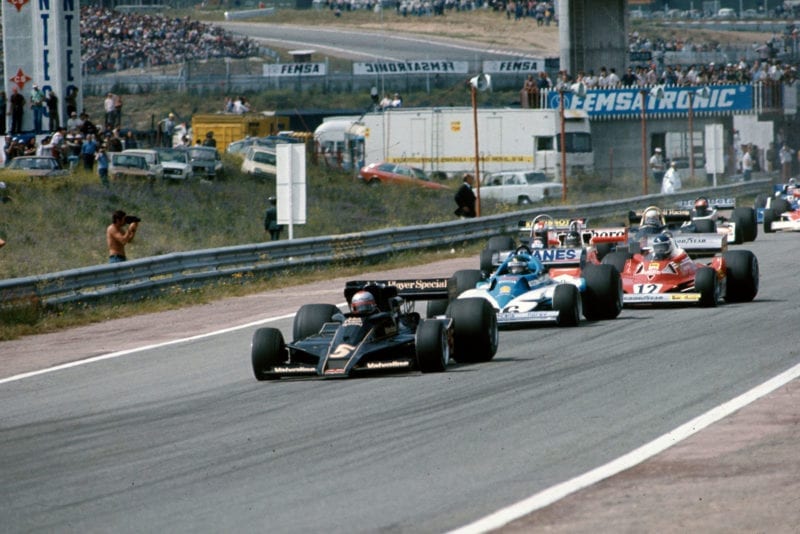
Andretti takes the lead at the start
Motorsport Images
The warm dry weather continued into Sunday and the morning “warm-up” session took place while the non-qualifiers either packed up and went home or took up vantage points to watch the fun. For Lauda there was no fun at all for he was suddenly attacked by a vicious pain in his side while driving round one of the hairpins. He was rushed off to hospital and it was discovered that he had a cracked rib! At first it was thought that he had damaged it with his elbow while changing gear, but it seemed very unlikely. More likely that something had given way in his internal bone structure, due to his body not mending as quick as his mind and will-power. Whatever it was there was no question of him taking part in the race and this let the first non-qualifier join the ranks on the back of the grid, this being Brett Lunger with his private March 761.
Although everyone had been at the track since early morning the race was not due to start until 4.17 p.m. (why not 4.15 p.m. or 4.20 p.m. no-one seemed to know). After a warm-up lap from the pits the cars lined up on the grid, the King of Spain arrived, the cars did another warm-up lap, everyone assembled on the grid, with Lauda’s spaced left unoccupied, the green light came on … and Andretti was gone. Reutemann shot across from the left to the right, Scheckter made a hesitant start in 2nd gear because he could not select bottom, and Hunt made a scorcher of a start from the fourth row. Around the first hairpin the Lotus was already a measurable distance ahead, followed by Laffite, Reutemann, Hunt, Watson, Scheckter, Regazzoni and Brambilla, the Italian Surtees driver having equalled Hunt for a good getaway. The rest followed and the 24 cars formed a “crocodile” as they wound their way through the twists and turns. It took but one lap to show that barring accidents or breakdown, no-one was going to catch Andrew and the Lotus, for he had already opened up a gap between himself and Laffite in the Ligier. The Frenchman was just about holding the Lotus, while Reutemann was keeping them in sight but the rest were falling back. Hunt’s engine had been misfiring on the warm-up lap and though a change of plugs had appeared to cure it, the misfire started again. On lap 5 he had been passed by Watson and Scheckter and had been struggling to stay ahead of them, so at the end of the next lap he went in to the pits and the mechanics changed the ignition unit. This was not the answer and after 10 laps the World Champion gave up the hopeless task. What a pity the rules of Formula One forbid drivers from changing cars, for on lap 6 Jochen Mass was lying tenth and if he had come in on the next lap and Hunt had taken over it would have been interesting to watch his progress up the field in the M23. Such legendary deeds as performed by Fangio, Moss or Jim Clark are now gone forever, and some of those people in the know will tell you that a driver could not achieve the impossible today, it’s all too complicated and technical, they say. If you look at the starting grid of this race and the fastest race laps that are given in brackets, you will see that the overall fastest lap was recorded on lap 5, and most of the drivers had given up trying within ten laps, and were cruising round to collect the money at the end.
Hunt’s spirited approach to motor racing would have seen him have a real go and we might have seen some inspired Grand Prix driving instead of the professional procession that actually took place. For Andretti there was no need to indulge in heroics or inspired driving, any more than he was doing, for he had the race in the bag, and even more so after lap 12, for at that point Laffite went into the pits as the Ligier was swaying about at the back. It was found that the right rear wheel was loose, which caused a lot of screaming and yelling in the Ligier pit. Laffite rejoined the race in nineteenth position, black with rage, and drove really hard for the rest of the race to get back up to seventh position. It was not inspired, for he got bogged down behind Nilsson for too long, when he was trying to unlap himself from the Swede. With the Ligier gone and Reutemann clearly settling for second place, Andretti had it all his own way and he drove a smooth and unruffled race in the style of the real professional that he is. The Lotus never missed a beat and gave him one of the nicest races he had ever had.
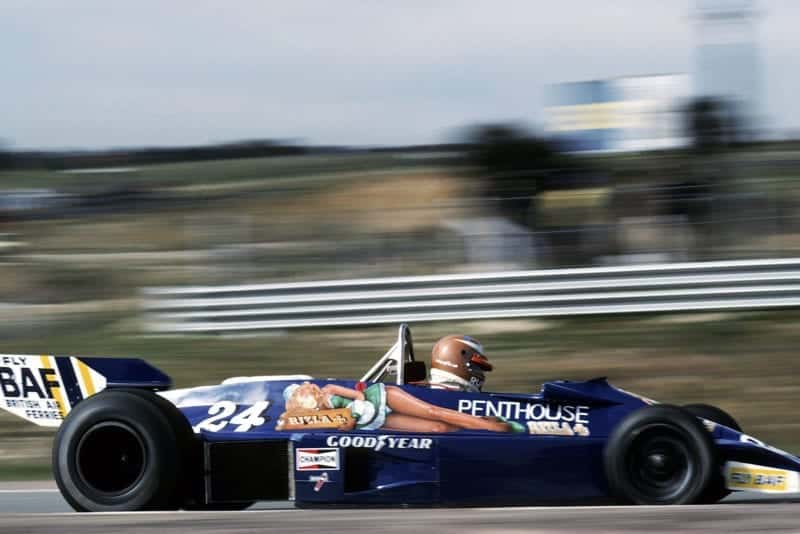
Rupert Keegan crashed out on Lap 16
Motorsport Images
If the lead was a bit dull for those who are not Lotus enthusiasts, the rest of the runners provided plenty of light entertainment. Brambilla collided with Regazzoni in the most unruly fashion at the exit from the first hairpin, and they both disappeared into the scenery! For once Regazzoni was entirely blameless for Brambilla had had his usual “brain-fade”, and wisely kept his helmet on as he tried to apologise, otherwise he might have had a Swiss fist buried deep into his brain. Somewhile later Alan Jones got into the same situation with Peterson, on two occasions, both times managing to scrabble back onto the track. The third time the Shadow hit a rear wheel on the Tyrrell and bent its front suspension, which put Jones out of the race after a courageous drive. Peterson’s Tyrrell had earlier broken a rear anti-roll bar mounting and was now a bit out of line, so the Swede had plenty to complain about after the race, even though he was happy to have finished. His team-mate Depailler lasted no time at all, for his Coswonh engine blew up.
In spite of a week of testing and a week of preparation and practice most of the cars seemed to be falling to bits during the race, if the drivers are to be believed. If clutches were not working properly, gearboxes were mal-functioning, or brakes were out of balance, or engines were down on power, or the aerodynamics were wrong, or the tyres were wrong, either too hot or too cold, but for Andretti everything was fine. Afterwards it was a pleasure to hear him explain how everything ran perfectly, no heroics, no bravery, no battling against the odds. “It was all down to Colin Chapman, he engineered the whole thing, I just drove it” he said.
There were some good dices among the nonwinners, such as that between Scheckter and Mass, the German trying very hard to rattle the South African, but failing valiantly, while Watson and Nilsson had a good run until the Brabham used up its tyres. Watson stopped at the pits and then the engine would not restart for the electric fuel pump had given up the ghost. Keegan had been acquitting himself well in the Hesketh with a good ninth position, behind Peterson and Jones, in spite of the Hewland box wanting to jump out of gear. Before half distance it did it once too often, on the fast downhill right-hand bend and the debutant spun off as the back-end got away from him. Poor Fittipaldi found himself sandwiched between Hans Binder and Patrick Neve, and when he could stand it no longer he stopped at the pits and fitted some new tyres, but it made little difference to his progress, other than now being last of all, behind Villota.
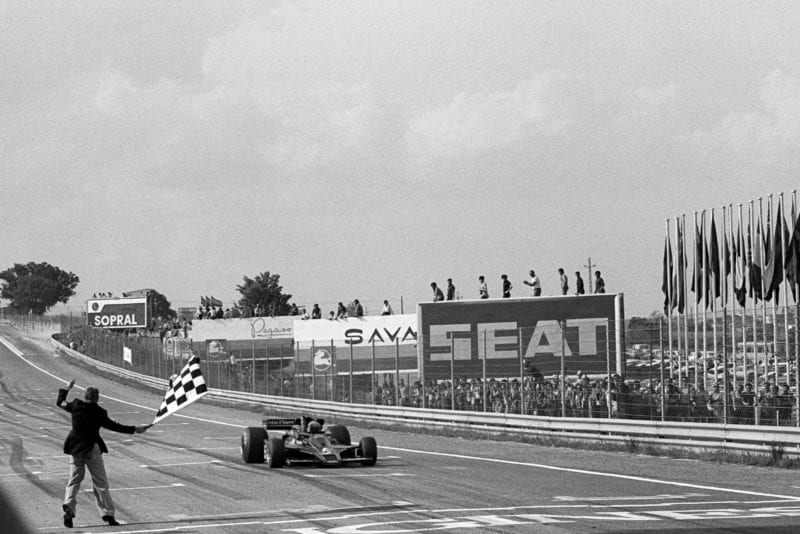
Andretti takes the chequered flag
Motorsport Images
As my young colleague said “Not the sort of stuff from which legends are made”. D.S.J.
